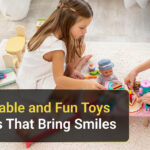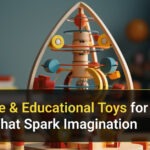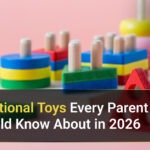When we think about raising children who are curious, confident, and well-rounded, the environment they grow up in matters a lot, and so does the kind of play they engage in. Simple playtime isn’t just a break from school or a way to burn energy: it’s a cornerstone of development. The right toys for kids can help children build language, motor skills, emotional awareness, creativity, and social competence, all long before they realize they’re “learning.”
In this blog, we’ll explore how play evolves from infancy to pre-adolescence (0-12 years), why choosing age-appropriate and meaningful toys matters, and we’ll highlight some standout options from GRAFLO to illustrate the kinds of tools you can use at home. Whether you’re a parent, caregiver, or educator, you’ll get a sense of how to pick playthings that genuinely support growth, not just entertain.
Why Play and the Right Toys for Kids Matter
From the moment babies are born, their brains are busy wiring up. They learn through touch, movement, sound, imitation, and repetition. During these early years, especially 0-3, play is a primary way they investigate their world. It’s not about formal “lessons”; it’s about freedom to explore and safe materials to experiment with.
As children move into preschool and early school years, the complexity of play increases: they ask “what if,” they build things, they imagine stories, and they engage socially. This process supports cognitive development (like problem-solving, memory, and focus), fine and gross motor skills, language growth, and emotional regulation.
So when you choose toys for kids, you aren’t just picking something fun; you’re selecting tools that can scaffold their next developmental stage. It’s also worth noting that the best toys often allow for open-ended play, meaning the child can explore multiple ways of using them, rather than a one-way “insert plug here” toy. Open-ended toys encourage creativity, persistence, and experimentation, all key to development across ages.
Age-by-Age Guide: What to Look For & Sample Toys
0–2 Years: Foundations of Movement, Sensory & Language
At this stage, children are mastering rolling, sitting, crawling, toddling, reaching, grabbing, mouthing (safe toys), noticing sounds, and beginning to speak. So look for toys that:
- Encourage reaching, grasping, and fine motor control (blocks, chunky shapes).
- Provide sensory feedback: textures, colors, sounds, and movement.
- Support language: simple picture books, naming objects, and cause-and-effect toys (push a button → sound).
- They are safe: large parts (to avoid choking), non-toxic materials, and sturdy.
GRAFLO provides toys for kids that you can use. Their washable finger-paint sets (ages 1–6) as a creative way to combine sensory fun and early mark-making. From their Art & Crafts category: Vibrant Washable Finger Paint for Toddlers: 12 Non-Toxic Colors (50 ml) for Ages 1–6. This kind of product helps toddlers explore color, texture, and movement of hands, which is foundational for visual motor skills and creative expression.
3–5 Years: Building Motor Skills, Imagination & Social Play
In this preschool period, children refine their gross motor skills (running, skipping, climbing) and fine motor skills (cutting, threading, drawing). They also enjoy imaginative play and are developing language, early reasoning, and taking turns.
What to look for when selecting toys for kids:
- Building sets (blocks, magnetic tiles) that allow construction and experimentation.
- Arts & crafts that let them visually express themselves and refine fine motor skills.
- Outdoor movement toys that improve coordination and balance, and encourage play with friends.
Here’s a great option from GRAFLO: GRAFLO 70-Piece Magnetic Tiles Set – STEM Building Toy for Kids 3+ | Safe & Creative Fun. This set allows children to build structures, towers, and shapes; they learn about spatial awareness, balance, planning, and fine motor control, all while feeling a sense of constructive achievement. Plus, it’s open-ended; they decide what to build.
Another good pick: Magical Mermaid Purse & Jewelry Set for Girls Ages 3–8. While more craft-/role-play-based, it still supports fine-motor skills (beads, clasps), imaginative play, and social sharing (making accessories for friends).
6–8 Years: Skills, Creativity, Early Problem-Solving
School-age children begin to engage more deeply in reasoning, planning, social collaboration, rule games, and representation of ideas. They’re ready for toys that challenge them more: building with purpose, creating their own designs, and using structured materials.
Look for:
- STEM sets: building, magnets, gears, and cause and effect.
- Craft kits that require more steps, planning, and sequencing.
- Outdoor/active toys to support energy and coordination.
- Toys that foster social play (team-building, sharing, and planning).
Examples from GRAFLO:
- Alphabet Bracelet Making Kit for Girls – 1100 Beads & Charms (Ages 6–12). This craft set supports sequential thinking (which letter comes next), fine motor skills (threading beads), creativity (designing own jewelry), and even emergent spelling/language practice (forming names and words).
- Spin Art Machine Kit for Kids – Creative STEM Paint Toy, Ages 6+. This combines art and movement/physics (spin, centrifugal motion) while letting the child experiment and iterate, which is great for creativity, cause-and-effect, and decision-making.
9–12 Years: Refining Thinking, Real Projects & Independence
As children approach pre-adolescence, they’re ready for more complex toys: ones that demand planning, multi-step procedures, collaboration, competition, and often real-world thinking. They appreciate “grown-up” play but still benefit from tangible, hands-on sets.
What to look for:
- Advanced building sets (magnetic tiles with many pieces, gear kits, and robotics, if available).
- Craft or design kits with higher complexity and independence.
- Outdoor toys and movement that support coordination and responsibility (e.g., scooters, ride-on toys).
- Collaborative or team play experiences: group builds, challenges.
From GRAFLO:
- Ultimate Magnetic Building Blocks for Kids – 100 PCS STEM Montessori Magnet Cubes (Ages 3-13). For older children, this becomes exciting as they design bigger structures, maybe even working in a team.
- GRAFLO Electric Scooter for Kids – 150W Motor, 16 KM/H, Rechargeable Battery, LED Lights – Ages (8-12 Years). This is more active/physical play. supporting coordination, balance, and outdoor freedom, and also giving children some independence and responsibility (learning to ride an electric scooter safely).
What Makes a Good Toy for Development? (Beyond Age Labels)
While age ranges help guide you, the quality of the play experience matters more than the label. Here are the key criteria for evaluating toys for kids in terms of developmental benefit:
- Open-ended vs. fixed-outcome: Toys that allow multiple ways of use (build, deconstruct, recreate) support creativity and adaptability.
- Skill scaffolding: A toy should challenge a bit beyond the child’s current level (the “zone of proximal development”). If it’s too easy, they’ll be bored; if it’s too hard, they’ll give up.
- Hands-on, tangible experience: Touching, manipulating, and feeling real materials supports motor and sensory skills more than purely digital play.
- Promotes persistence and reflection: Toys that involve trial-and-error, planning, and adjustments help kids learn how to think rather than just do.
- Facilitates social interaction or independent focus: Play sometimes needs company (siblings, friends, parents) and sometimes independence. Both matter.
- Safe, durable, quality materials: Especially critical for younger ages. GRAFLO emphasizes durable ABS plastics with safe finishes for its construction sets.
- Encourages movement and health: Physical play is vital; outdoor movement, coordination, and balance matter for growth.
How to Integrate the Right Toys Into Daily Life
Selecting the toy is only half the job. The environment and how you facilitate play are just as important for development.
- Create a play zone: A dedicated corner or space where children can safely build, paint, create, and move. Keep supplies accessible (blocks, craft kits, beads) and rotate them.
- Allow unstructured time: Kids need time to explore toys without scripted direction. Let them decide what to build or how to use a kit.
- Be a play partner: Especially early on, joint play is powerful. Ask open questions (“What would happen if you changed this piece?”) to deepen thinking.
- Rotate toys: Even the best sets get stale. Alternate between building, crafting, active movement, and role-play.
- Encourage challenges: Set a mini-goal (“Let’s build a tower that reaches the ceiling”) or a game (“Who can design the strongest bridge?”).
- Link to real life: For older kids, connect play to bigger ideas: designing a scooter ride path safely, using blocks to model a real building, using craft kit jewelry as gifts, and thinking about materials.
- Limit screen time: Use physical toys to balance or replace passive screen use. This helps sustain attention, imagination, and interaction.
- Celebrate creation: Display built structures, craft projects, and scooter achievements. Recognition motivates future play and persistence.
Common Mistakes to Avoid
Even with the best intentions, parents often fall into habits that unintentionally reduce the developmental value of play. One of the most common mistakes is buying too many toys at once. While it may seem generous to offer a wide variety, having too many options can overwhelm children and cause them to lose interest quickly. Instead, it’s better to invest in a few high-quality sets and rotate them periodically. This keeps playtime fresh and encourages children to rediscover older toys with renewed curiosity.
Another frequent error is choosing toys solely for their entertainment value. Bright lights and sounds might grab attention, but they don’t always nurture learning or creativity. It’s important to prioritize toys for kids that inspire imagination, problem-solving, and exploration. These types of toys encourage children to think critically and engage meaningfully with what they play.
A surprising yet common mistake is leaving toys boxed or unused. A toy’s potential lies in active play, not in storage. Parents should make toys easily accessible and encourage children to use them freely. When toys are visible and inviting, they’re more likely to spark spontaneous and creative play sessions.
Another pitfall is engaging only in “watch me” play. While it’s wonderful to observe your child’s creativity, limiting play to passive supervision reduces interaction and learning opportunities. The best approach is to become a facilitator, join in occasionally, ask questions, or help set small challenges that make playtime more dynamic and meaningful.
Lastly, using age labels too rigidly can limit a child’s potential. Every child develops at their own pace, and interests often cross age boundaries. While age recommendations are helpful for safety and skill level, parents should focus more on observing their child’s individual interests and abilities. Adapting toy choices to those cues ensures both enjoyment and developmental benefit.
Final Thoughts
The age range from birth through 12 years is a remarkable journey. from rolling and grasping, through imaginative play, to independent creation and complex reasoning. During this journey, the toys for kids you choose, and how you use them, become more than just playthings: they become tools for growth, expression, movement, and connection.
Brands like GRAFLO offer thoughtful choices across ages, from magnetic building sets through craft kits to active movement toys, each with the potential to support child development in meaningful ways. By choosing well-constructed, open-ended, skill-supporting toys and integrating them into a rich play environment, you give children the chance not only to have fun but also to learn, adapt, create, collaborate, and thrive.
Whether your child is painting glowing wood shapes, building magnetic towers, designing bracelets, riding a scooter, or experimenting with spin art, each of these moments matters. So the next time you browse “toys for kids,” remember: it’s not just about the piece in hand; it’s about the brain wiring, the muscle coordination, the imagination ignited, the social interaction fostered, and the memory made.
Play well. Grow well.






